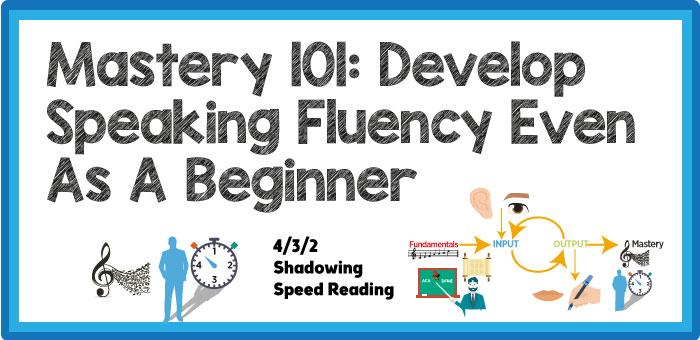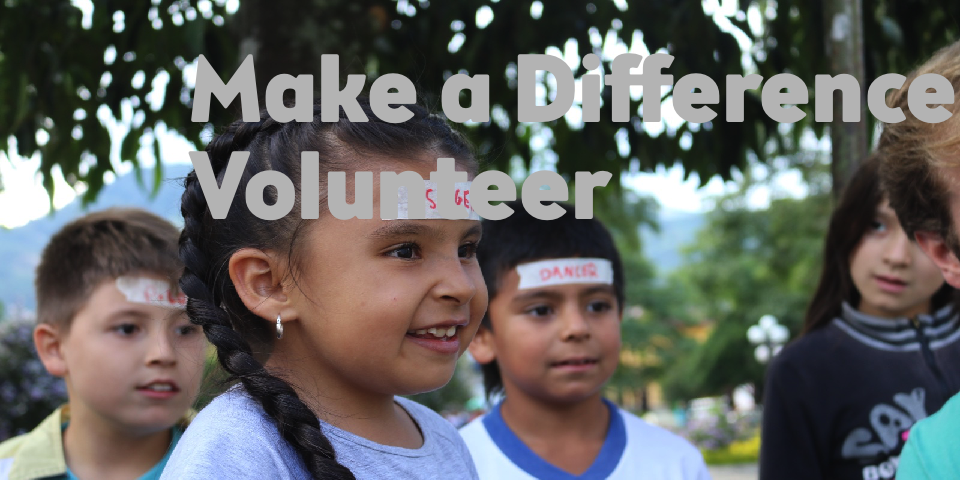
The ACA Method involves an equal balance of practice and exposure between:
- Input
- Output
- Fundamentals and
- Mastery
Mastery, which could also be referred to as ‘fluency development’ is something that is normally either never incorporated into most language learning classrooms, or if it is, is only considered for advanced students.
This is because of an erroneous assumption that fluency is a level to be reached, and not a skill to be mastered.
This is precisely why ACA uses the phrase Mastery instead of fluency… mostly because the ‘F-Word’ has become so encumbered with stress and causes students to compare themselves to some mythical ideal.
But Mastery or fluency development is about getting more ready access to what you already know.
It is about taking what you’ve learned from Input, Output, and Fundamentals, and synthesizing them into a cogent whole. It is about being able to use your new language to communicate more easily, more fluidly, and with more meaning.
Acquiring New Words Is Not Enough
Language: the whole is more than its parts. Without turning this article into an epistemological debate, language is about more than simply acquiring new translations to already ‘known’/understood words: scaffolding your native language’s mental map with a new one called Spanish.
In reading or writing, in speaking or in listening, it is not sufficient to merely know the meanings of all the words used in context. It is more important to be able to have ready (quick) access to use and process these terms with Mastery – quickly and in completely new ways.
You may ‘have’ a Spanish vocabulary of 2,000 words, but unless you can access each one in under a fraction of a second, you could certainly use more Mastery practice.
The Hallmark of Mastery Activities: 4/3/2
So, how does ACA promote Mastery practice?
While Mastery-lite activities can be done at any time (by simply promoting any kind of external pressure – be it pressuring activities to be done at a faster time or with perfect accuracy), true Mastery activities definitely have their role and their own space.
The hallmark fluency development activity is the 4/3/2 activity (that ACA often simplifies to a 3/2/1 paradigm).
4/3/2: Using Time to Add Pressure
4/3/2 asks student learners to speak on a given topic for 4 minutes. Then to give the same talk in 3 minutes. And then in only 2 minutes.
Students work in pairs or the pair is student-teacher.
The activity begins with the interrogator asking the interviewee to discuss a certain topic (‘What is the earliest birthday party you remember having?’) and allowing them time to prepare/jot down a few notes (depending on the teacher, the students in the class, etc.).
Then they have 4 minutes to speak. The interrogator/teacher should write down the main points of what was said.
The student now has time to collect themselves/prepare mentally for the next round.
Now they have to give the same discourse but in only 3 minutes. Again, the interrogator should be attentive so as to assure each point is being discussed.
If they made it through that, they should be sweating a bit, especially knowing that they have to go again…
Finally, they have to say everything again, but this time in only 2 minutes. Obviously, this is not going to be easy. There are going to be plenty of ‘Uhhs’ and ‘errs’ and success is far from guaranteed.
But that’s okay. Mastery practice is not about being perfect: its about putting the brain in panic mode while using your new language and coming out the other end unscathed.
4/3/2 (or 3/2/1) exercises can be done with speaking and writing.
I’ve also successfully done it with listening activities (having them listen to specific passages and answer related questions) and have done it personally with reading to improve my own Spanish.
Mastery Activities Across All Four Domains of Language

- Language Input – Listening, Reading
- Language Output – Speaking, Writing
Input Mastery – Listening, Reading
Listening – Serial Reading/Controlling the Teacher
Serial reading involves introducing longer texts over the course of multiple classes.
At first, the story is read slowly, with particular attention paid to new words, new word forms, new word orders, and any salient points being written out for the whole class.
As the story progresses, either throughout the one lesson or the entire story, the teacher starts to read more normally and less time is spent stopping and writing out new words.
Controlling the teacher is all about Mastery: it puts the students in the driver’s seat!
First, before reading a short passage to the class, the teacher teaches a few key phrases and writes them on the whiteboard. Things like “Please read slower” and “Please repeat…” and “Please go back to the beginning” etc. This unites listening comprehension with speaking ability while also pushing the students to listen to a text a bit above their paygrade.
Reading – Speed Reading/Repeated Re-reading
A speed reading program is a phenomenal supplement to language development. It involves Mastery practice by getting oneself used to processing a lot of language forms in a short amount of time.
Class time can be spent with speed reading by using timed exercises:
- Read, and comment on, as much as possible of the text within X minutes.
This develops scanning and skimming abilities which is a specific and incredibly useful language ability rarely practiced.
Repeated re-reading fast-tracks a language learner’s ability to process textual information in the new language by exposing them to the same piece of reading multiple times.
Each re-reading could involve:
- a new task (answering a deeper/more profound contextual question)
- being done for time (in a 4/3/2-esque fashion or simply a set amount of time)
- a simple re-reading (studies point towards reading development occurs after several repeated re-readings)
Output Mastery – Speaking, Writing
The old standby 4/3/2 (or 3/2/1) works wonders but it isn’t the only Mastery exercise to develop good Output ability.
Speaking – The Best Recording/”Islands of Conversation”
Have a student record themselves speaking on a subject and have them listen and re-record until they and/or the teacher are satisfied with a best recording.
My favorite supplement to this exercise (for both young kids and adults learning English as well as travelers learning Spanish) is to make it into a project: to have the student work on creating a paragraph (or multiple) of text on a subject they feel passionate about (or something they know – due to hobbies, work, etc.) they will speak about often.
They work together on this text until both are satisfied. Then the student goes about memorizing it as if it were a monologue for a part in a play they were going to perform.
They will know this paragraph inside and out. It will become and Island of Conversation. Basically, a fully-developed, contextualized, piece of Mastery in a sea of unknowns.
Recording this with additional computer-based spectrogram analysis brings it even to another level.
Writing – Continuous writing/Morning Pages
Writing does often take a second seat to speaking abilities but if a student is sufficiently advanced in speaking they benefit a lot from writing practice, as it quite literally shapes and develops communicative thought in your new language.
Continuous writing, as it sounds, is an activity with a given amount of time (not more than 10 minutes) in which the student writes as much as possible on any topic. Write, write, write is the focus. As a result, teachers aren’t focused on correcting for accuracy at all.
Just like invented/incorrect spelling is part of a normal first language acquisition so is it the same with acquiring our second languages.
Teachers then try and give positive feedback and use the student’s writing exercise as a launching off point for further discussion and practice.
Morning pages is a creative writing exercise popularized by Julia Cameron in her book, The Artists Way, and it is something I do almost daily.
Basically, as soon as you wake up, you grab a notebook and start writing. Stream-of-consciousness-Yellow-Submarine-style-of-writing.
Write as if you are basically just out the door (with friends yelling for you to come on!) leaving for a party but have to write a quick note for your roommate first so they know where you are going.
The focus is much more on stream-of-consciousness. And as such, the penmanship is going to be so poor that it wouldn’t make any sense at all for a teacher to even try to comment: they wont be able to read it!
Other Mastery Activities
- Writing or talking about the same topic multiple times, sometimes with decreasing time limits.
- Retelling a story you’ve heard before
- Listening to or reading a text multiple times with varying levels of difficulty
- Role plays and storytelling
- Ask-and-answer
- Class games but for time
- Calling another student on the phone and practicing telephone talk.
- Speed interviews
- Having students go and do simulated activities: buying food, buying a bus ticket, etc.
As you can see, coming up with Mastery exercises is challenging but important. Mastery exercises cement the learning that took place along the four strands of languages: listening, reading, speaking, and writing.
It isn’t for advanced students only but should be incorporated from the very beginning!

